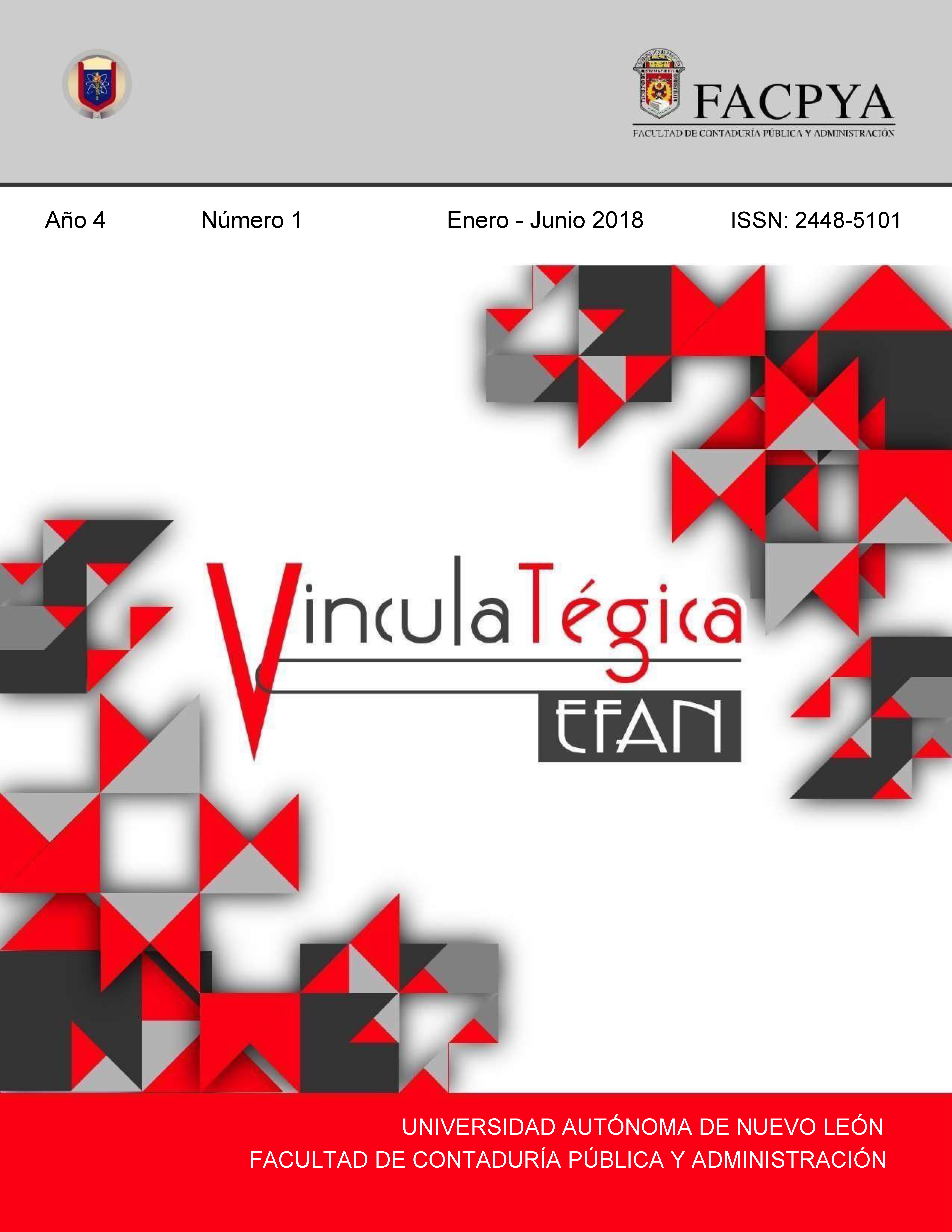Las tecnologías de la información y la comunicación y las tecnologías del aprendizaje y del conocimiento: adaptación al cambio digital
DOI:
https://doi.org/10.29105/vtga4.1-811Keywords:
pequeña y mediana empresa, internacionalización empresarialAbstract
This paper analyses the problems that small and medium-sized Mexican companies face in the following issues : a) Registering themselves in the Tax Administration Office (SAT) performing an economic activity rather different from the real one they perform; b) abstaining from registering to the sectorial list that originally correspond to them. c) entrust the legal issues of the company to legal advisers of low cost and low performance; d) avoiding to invest in human resources that perform efficient administrative functions; e) postpone the professionalization of company managers. After reviewing each of these problems, their effects on the internationalization costs of this type of companies are analyzed.
Downloads
References
Adams, S. (2013). México el país con mayor insatisfacción laboral de Latam. Revista Forbes. Recuperado de https://www.forbes.com.mx/mexico-el-pais-con-mayor-insatisfaccion-laboral-de-latam/
Cardona, M. et al (2007). Capital humano: una mirada desde la educación y la experiencia laboral. Grupo de estudios sectoriales y territoriales. Medellín, Colombia. Recuperado de file:///C:/Users/Eric/Downloads/1287-1-4196-1-10-20120730.pdf
CEPAL (2003). Declaración de Bávaro en Conferencia Ministerial Regional preparatoria de América Latina y el Caribe para la Cumbre Mundial sobre la Sociedad de la Información (29-31 de enero de 2003). Bávaro, Punta Cana, Republica Dominicana. Recuperado de http://www.eclac.cl/prensa/noticias/noticias/9/11719/Bavarofinalesp.pdf
Chiavenato, I. (2007). Administración de recursos humanos. El capital de las organizaciones. México: D.F. Mc Graw Hill.
CONCANACO SERVITUR (2017). Indicadores Tabasco, México. Recuperado de http://www.concanaco.com.mx/documentos/indicadores-estados/Tabasco.pdf
DENUE (2016). Directorio Estadístico Nacional de Unidades Eco- nómicas. Recuperado de: http://www.beta.inegi.org.mx/app/mapa/denue/
Diario Oficial de la Federación (2009). Estratificación de las micro, pequeñas y medianas empresas. Recuperado de: http://dof.gob.mx/nota_detalle_popup.php?codigo=5096849.
Escuela Europea de Management (2017). Capacitación y desarrollo personal en una empresa. Recuperado de http://www.escuelamanagement.eu/desarrollo-personal/capacitación-desarrollo-personal-una-empresa
Falola, H.O.; Osibanjo, A.D.; Ojo, S.I. (2014). Effectiveness of training and developmente on employees' performance and organization competitiveness in the Nigerian banking industry. Bulletin of the Transilvania University of Brasov. Serie V: Economic Sciences. Vol. 7
FAO (2014). Metodologías de E-learning. Recuperado de http://www.fao.org/elearning/Sites/ELC/Docs/FAO_elear- ning_guide_es.pdf
Flores, I. (2015). E-learning: la importancia de los cursos y capacitación vía Internet. Piensa en mercadotecnia. Recuperado de http://www.themarkethink.com/mercadotec- nia/e-learning-la-importancia-de-los-cursos-y-capacita- cion-via-internet/
Ghaffor A.; Ahmed, F.; Aslam, M.; (2011). Impact of training and development on organizational performance. Volume 11 Issue 7 versión 1.0 July. Global Journal of Management and Business Research
Guinazu, G. (2004). Capacitación efectiva en la empresa. Invenio, 7(12). Universidad del Centro Educativo Latinoamericano Rosario, Argentina. Recuperado de http://www.redalyc.org/pdf/877/87701209.pdf
Hernández, R.; Fernández,R.C. & Baptista, P. (2010). Metodología de la Investigación. México: D.F. Mc Graw Hill.
Hermans, M. (2017). Capacitación: ¿puede mejorar el clima laboral? La Nación. Recuperado de: https://www.lanacion.com.ar/1981987-capacitacion-puede-mejorar-el-clima-laboral
IDC (2017). Cargas excesivas, principal problema laboral en México. Revista IDC Asesor Fiscal, Jurídico y Laboral. Recuperado de https://idconline.mx/laboral/2017/08/21/cargas-excesivas-principal-problema-laboral-en-mexico
INEGI (2014). Minimonografía Tabasco. Censo Económico 2014. Recuperado de http://www.inegi.org.mx/est/contenidos/ Proyectos/ce/ce2014/doc/minimonografias/mtab_ce 2014.pdf
Khan, B. H. (1997). Web-Based Instruction (WBI): What Is It and Why Is It? En Khan,B. H. (Ed.).Web-Based Instruction, 5-18. Nueva Jersey: Englewood Cliffs
LFT (2012). Ley Federal del Trabajo publicada con las últimas re- formas el 30 de noviembre de 2012. Recuperado de https://www.uv.mx/uge/files/2014/05/Ley-Federal-del-Trabajo.pdf
NetPartner (2017). Razones para incorporar el e-learning en tu em- presa. Recuperado de http://www.netpartnerlearning.es/blog/razones-para-incorporar-el-e-learning-en-tu-empresa/
Probst, G., Raub, S. y Romhardt K. (2007). Administre el conocimiento. México: DF. Pearson Educación. Recuperado de http://revistas.unimagdalena.edu.co/index.phpclioa- merica/article/download/422/386
Rosenberg, M. J. (2001). E-learning. Strategies for Delivering Knowledge in the Digital Age. New York: McGraw-Hill
Siliceo, A. (2014). Capacitación y desarrollo del personal. 5ª edi- ción. México: Editorial Limusa.
Tavera, J. (2014). Cinco defectos de los trabajadores mexicanos. Expansión. Recuperado de https://expansion.mx/especiales/2014/05/06/5-defectos-de-los-trabajadores-mexicanos
Werther W. y Davis K. (2008). Administración de recursos huma- nos, el capital humano de las empresas. México: D.F. McGraw-Hill.
Villalobos, G. y Pedroza, R. (2009). Perspectiva de la teoría del capital humano acerca de la relación entre educación y desarrollo económico. Tiempo de educar, 10(20). Universidad Autónoma del Estado de México. Toluca, México.
Villaseca, J. y Torrent, J. (2007). Principios de economía del cono- cimiento. Hacia una economía global del conocimiento. Madrid: Ediciones Pirámide. Recuperado de http://dialnet.unirioja.es/servlet/libro?codigo=30968o
Downloads
Published
How to Cite
Issue
Section
License

This work is licensed under a Creative Commons Attribution 4.0 International License.
a). Authors keep copyright and give the journal the right of the first publication of the work under a Creative Commons attribution license. This license allows others to share the work as long as original authorship and initial publication in this journal is acknowledged.
b). Authors may make other independent and additional contractual agreements for the non-exclusive distribution of the version of the article published in this journal (e.g., include it in an institutional repository or publish it in a book) as long as they clearly indicate that the work was published for the first time in this journal.







